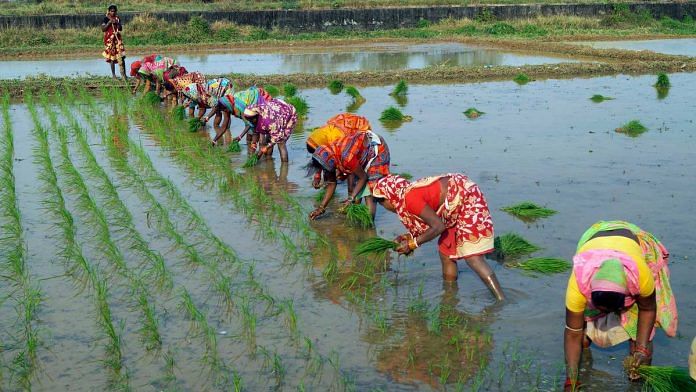New Delhi: India’s total foodgrain production in 2020-21 is set to hit a record 303.34 million tonnes (MT), according to the second advance estimates for major crop production.
The fresh estimate is 5.84 MT, or nearly 2 per cent, higher than last year’s total foodgrain production of 297.50 MT, and 24.47 MT, or 8.77 per cent, higher than the average production over a five-year period between 2015-16 and 2019-20.
Sugarcane production is estimated to hit 397.66 MT in 2020-21, 27.16 MT more than the previous year’s figure and 35.59 MT higher than the last five years’ average.
These record-high estimates come at a time when India has registered above-average rainfall — the total rainfall from the south-west monsoon up to 30 September 2020 was nine per cent higher than the long period average (LPA).
Also read: How Covid worsened hunger in India, the world’s largest food basket
Most crops are booming
Among the major foodgrain crops, the total production of rice during 2020-21 is estimated at a record 120.32 MT, 7.88 MT higher than the last five years’ average production of 112.44 MT.
It’s a similar story for wheat, with the new estimate of 109.24 MT far exceeding the five-year average of 100.42 MT.
In terms of pulses too, the 2020-21 production estimate of 24.42 MT is 2.43 MT higher than the five-year average, and 1.40 MT more than last year’s figure. Among these, gram production is set to see the biggest jump to a record 11.62 MT from 11.07 MT last year.
Among oilseeds, soybean is set for the biggest rise, with an estimated production of 13.71 MT, 2.48 MT higher than last year and 2.28 MT higher than the five-year average. Oilseed production as a whole is set to be 37.31 MT, 4.09 MT higher than last year and 6.77 MT higher than the five-year average.
However, this bumper production — especially in wheat and paddy, for which these are assured procurement at MSP — has led to mounting stockpiles, and given rise to a storage problem over the years.
As of February 2021, the Food Corporation of India had 561.93 lakh metric tonnes (LMT) of foodgrain in its stock (243.62 LMT rice and 318.31 LMT wheat), nearly 3.5 times above the buffer stock norm of 164.10 LMT (56.10 LMT rice and 108 LMT wheat). In comparison, the FCI’s stockpile in February 2019 was 467.27 LMT.
Future course of action
Dr Arabinda K. Padhee, country director of the International Crops Research Institute for the Semi-Arid Tropics, told ThePrint that while the new production estimates were “big news”, especially oilseeds, some realignment of policy priorities was needed.
“India needs to boost production and productivity of both pulses and oilseeds crops for self-sufficiency and reducing import burden. Pulses are more important for the nutrition security of the country,” Padhee said.
He pointed out that production of nutri-cereals has not risen by much — it is estimated by the government to be 49.36 MT in 2020-21 compared to 47.75 MT the previous year — and said promotion of millets should be taken up on “mission mode”, with focus on changing consumer behaviour.
“This will have multiple benefits, including climate resilience and corrections of micronutrient deficiencies,” he said.
Padhee added that the increase in rice and wheat output has a “serious message” for the policy space, and crop diversification must be incentivised where they are unsustainable.
He also batted for the Narendra Modi government’s new farm laws, saying: “A robust value chain will help sustain the momentum, with more income to farmers. The recent farm laws, with proper implementation, will help.”
(This report has been updated to clarify that the figures cited for nutri-cereals are from the government, not Dr Padhee.)
Also read: Save Punjab from desertification, move paddy-wheat to UP, Bihar, Bengal — agronomist SS Johl



